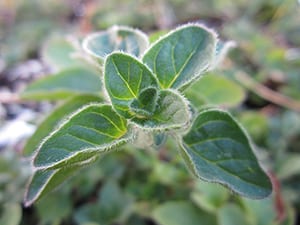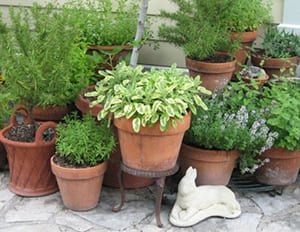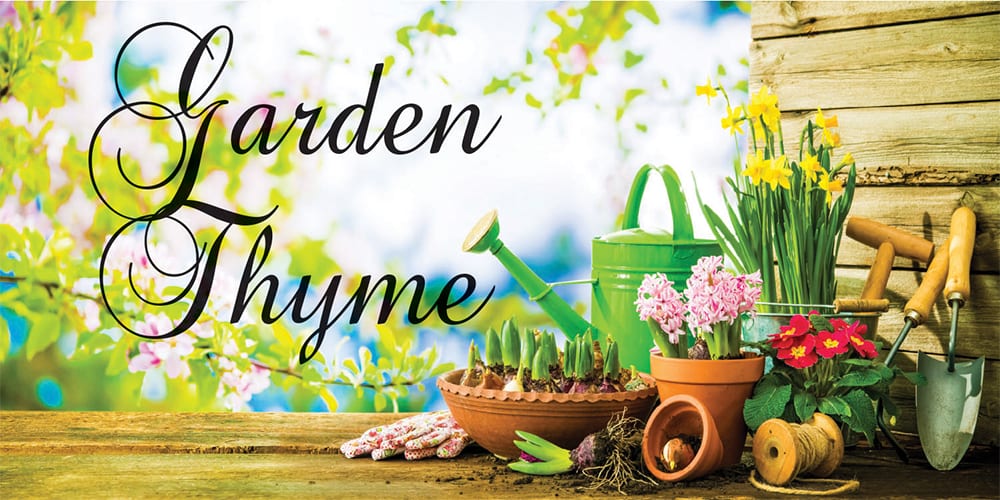With many of us staying home right now and cooking meals more often, adding herbs to our dishes can enhance flavor and brighten your plate with color. Spring is an excellent time to start planting herbs that will grow throughout the season.
Many herbs can be started from seeds. However, some herb seeds take a long time to germinate and may not grow large enough this year for significant use in the kitchen. The better choice is to buy small plants from a garden center or farm market to begin your season.
Choosing herbs to grow depends on your culinary preference. Some herbs are great in sauces, to sprinkle on top of finished dishes, mixed in salads or to flavor drinks like teas or lemonade. Beside flavoring food, it is also important to know how herbs grow. Herbs, like many other plants grow as annuals or perennials.
Annual herbs are grown for one season and are generally not cold-hardy. After they die from frost or freezes, annual herbs are generally discarded and new plants are started each season. Examples of herbs grown as annuals include basil, marjoram, dill, cilantro and parsley.
Parsley is actually a biennial plant (it takes two life cycles to flower) and if winters are mild it may withstand surviving until the next season. Basil is the least cold tolerant and should be planted outdoors after the threat of frost passes in spring – around mid-May.

One of the best attributes of basil is this plant can be easily propagated from cuttings. Simply cut a shoot of a branch 4-6 inches in length, remove the lower leaves on the stem and place in a vase or glass of water and in 2-3 weeks enough roots should emerge from the cutting to plant in soil.
After the basil plant is well established, it may need fertilizer if the leaves start to become pale yellow and plant growth slows. Making cuttings and rooting them is a way to carry this annual herb over the winter indoors, as it grows well as a houseplant if given enough light.
Perennial herbs have the ability to come back year after year, if cared for properly and planted in protected areas. Some hearty favorites are sage, chives, rosemary, thyme, mint, lemon balm and lavender.

Understanding the growth potential and spread of some perennial herbs will help you decide if they are a good option for the garden. Some perennial herbs like mint (comes in many flavors and aromas), lemon balm and oregano produce underground rhizomes that spread to grow more shoots.
This makes these herbs more easily propagated by separating shoots to make additional plants, but also allows these herbs to spread rapidly to take over and compete with other plants growing in the same garden space. For this reason, you may want to plant these fast-spreading perennial herbs in containers.
Perennial herbs can also be brought indoors during winter if planted in containers. Before bringing the potted herbs inside for winter trim off any excess growth, check for and remove any insects or dead debris in pots, and be sure to place a drain tray under pots to catch water that may run out the bottom when watering.
Many herbs can be grown outside in containers and kept on patios, decks or other areas close to the home. Be sure to keep containers in sunny areas, as most herbs prefer full sunlight. Herbs can be grown in any type of container as long as it has drainage holes and is large enough to hold a fully grown plant.
Therefore, for full-season growth, larger pots that can hold at least 3 gallons of soil or more are recommended. For container grown herbs, do not use garden soil. Use loose, well-drained potting mix that will not stay too wet for long periods of time. Garden soil can be mixed with potting mix at a ratio of 1:2 parts.
More potting mix than garden soil is needed in the mix to ensure good drainage. Most herbs have fine root systems that do not tolerate water-logged soils. Soil that stays wet will suffocate roots and promote root diseases.
Most herbs also do well when planted in a garden setting. Having a separate garden for herbs, away from a vegetable garden or flower bed, can be an asset. Most vegetable plants grow more quickly and larger than herb plants and can shade smaller herbs or out compete herbs for water and nutrients.
To maintain steady and healthy growth of herbs throughout the season be sure to check and see if they need watering. Herbs planted in containers will not need frequent watering when if small, when first planted. As plants grow larger with more foliage they will use more water, especially on hot, sunny and windy days.
Herbs in containers that are watered often may need to be fertilized monthly since constant watering may leach nutrients held in the soil mix. However, do not over fertilize herbs as salts in some fertilizers may cause leaf tip burn. Use recommended rates on the package when applying fertilizers.
In order to promote healthy growth, pinch back shoots and some older leaves from plants to keep them bushy and compact. If not immediately using the cut off herbs, try drying or freezing them for use in the kitchen at a later date. Additionally, remove any dead, damaged or diseased leaves from the plant for maintenance.

For herbs that produce flower shoots, be sure to cut off any flowering tips when they first appear to promote leaf growth. Once plants begin flowering they start to senesce and begin the end of their life-cycle. Removing flowers or flower shoots will extend plant life.
When harvesting herbs use a sharp knife, pruning shears or sturdy scissors to removing top leaves and stems. When harvesting annual leafy herbs, leave four to six inches of shoots on the plant for better re-growth.
To harvest perennial herbs, remove only the top third of the plant, to allow for enough plant material to regrow. By removing plant tips or shoots, you will notice more branching of side shoots for exponential growth.
Besides adding flavor and having wonderful aromas, many herbs offer nutritional benefits. Take basil for instance. Basil leaves contain many healthy essential oils such as eugenol, citronellol, linalool, citral, limonene, and terpineol. These compounds are known to have anti-inflammatory, and antibacterial properties. Basil is also one of the best sources for essential nutrients, minerals, and vitamins.
Both flat leaf and curly parsley varieties, have been rated as one of the top plant sources with quality antioxidant activities and are a good source of minerals like potassium, calcium, manganese, iron, and magnesium. Parsley also contains vitamin-A, β-carotene, vitamin-C, vitamin-E, zeaxanthin, lutein, and cryptoxanthin.
To gain nutritional benefits of herbs, they need to be eaten often and in adequate amounts. Therefore, seek recipes that contain herbs as a main ingredient in your dishes. With basil, creating a pesto sauce is quick and easy. In a food processor, add 2 cloves of garlic, 2 Tbsp. of pine nuts (can substitute cashews or nuts can be optional), 3 cups packed with fresh basil leaves, 1⁄4 cup grated Parmesan cheese, black pepper to taste, and 1 Tbsp. lemon zest. Pulse until dry ingredients are finely chopped and then add 1⁄2 cup olive oil and grind until ingredients thoroughly mixed. Use as a spread on sandwiches, over meats and fish, or over pasta as a sauce (heat pesto in a sauce pan then toss with cooked and drained pasta).
Hopefully, herbs will become a staple in your garden and in your diet. Their fresh smells and flavor kick to dishes can be a welcome addition and straight from your own garden.
By Michelle Casella











